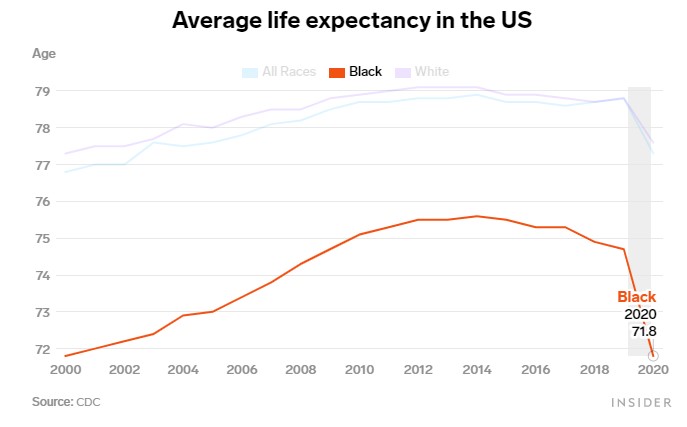Average life expectancy in the US plummeted by a year and a half in 2020 – the largest single-year decline since World War II, according to a new report from the US Centers for Disease Control and Prevention.
Life expectancy went from nearly 79 years in 2019 to just over 77 years in 2020, the report found.
For Black and Hispanic Americans, that decline was even more pronounced: around three years.
The average Black American had a life expectancy of nearly 75 years in 2019, but less than than 72 years in 2020. And the average Hispanic American had a life expectancy of nearly 82 years in 2019, but less than 79 years in 2020.
The last time Black Americans saw such a sharp decline in life expectancy was during the Great Depression. Last year also marked the largest single-year decline in life expectancy among Hispanic Americans, though the CDC just started tracking life expectancy among this group in 2006.
Dramatic drop-offs in life expectancy are "highly unusual" in modern US history, Elizabeth Arias, the report's lead author, told Insider.
"Human mortality, in developed countries especially, is pretty stable and constant," Arias said. "It changes very little from year to year."
But the pandemic has lowered the average life expectancy to levels last reported in the early 2000s. Black Americans now have the same life expectancy that they did in the year 2000, as shown in the chart below.

During the first half of 2020, Black Americans had the sharpest decline in life expectancy of any racial group. By the end of the year, however, Hispanic Americans showed a more significant drop-off.
The CDC researchers found that 68 percent of all COVID-19 deaths among the Hispanic population occurred during the second half of 2020, whereas COVID-19 deaths among Black Americans were fairly evenly distributed across the year.
Arias said she's not sure why that is yet, but it could have something to do with where the majority of these populations are located.
"We know that the Hispanic population tends to be concentrated in various states, so they're not distributed throughout the country," she said.
States with high shares of Hispanic residents – including California, Texas, Florida, and Arizona – saw particularly devastating surges of COVID-19 cases last winter.
COVID-19 also represented a higher share of deaths among Hispanic Americans than among Black or white Americans: 90 percent of the decline in life expectancy among the Hispanic population was due to COVID-19, compared with 68 percent of the decline among white Americans and 59 percent of the decline among Black Americans.
Life expectancy could take a few years to bounce back
Life expectancy isn't an indicator of when people will die – rather, it's a marker of the general health of the population. It represents the average number of years a person might live if they were to experience the current death rate throughout their entire life.
COVID-19 deaths were responsible for roughly 74 percent of the life expectancy decline in 2020, the CDC found. As these deaths taper off, life expectancy in the US could start to bounce back – but researchers expect that process to take a few years.
"We won't see life expectancy go back to what it was in 2019 this year," Arias said. "It might increase a little bit if we stay below the number of deaths that we saw in 2020. It may go down even further if – for example – because of the Delta variant we have significantly more deaths before the end of the year."
The CDC has already reported more than 230,000 COVID-19 deaths in 2021, Arias said, compared with around 375,000 COVID-19 deaths in 2020.
"Even if we were to able to eradicate COVID deaths completely, we will have the indirect effects of the pandemic present themselves in increases in other causes of death," she added.
In 2020, for instance, deaths from drug overdoses rose nearly 30 percent compared with the year prior – from around 71,000 to 93,000. Arias said it's possible that many of these deaths could also be linked to social or economic hardships from the pandemic.
This article was originally published by Business Insider.
More from Business Insider:
#Humans | https://sciencespies.com/humans/life-expectancy-in-the-us-has-totally-plummeted-and-its-not-all-due-to-covid/
No comments:
Post a Comment